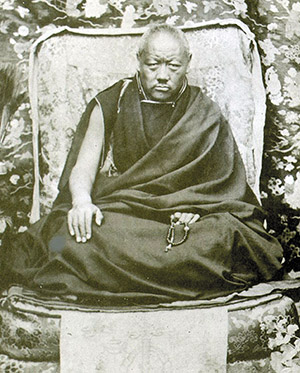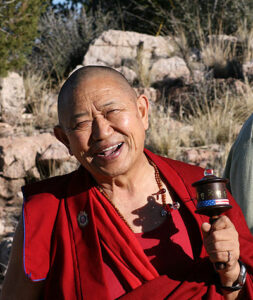The Era of the Chetsang and Chungtsang Rinpoches (1615-present)
During the time of the 1st Chetsang Rinpoche, Konchog Rinchen (1590–1655), the Tumat Mongols were claiming rights to Tibetan lands and properties, as the 4th Dalai Lama was a descendant of the Tumat clan. Thus the Drikungpa again found themselves embroiled in armed conflict and the fortress of Drikung Dzong fell to the onslaught of Mongolian troops. The entire region of Drikung lay in such ruin that Konchog Rinchen was unable to live there for a long time. When the Tsangpa king, Phuntsog Namgyal, succeeded in driving back the Mongols, Konchog Rinchen rebuilt Drikung Dzong in a very short time in 1624. He named the new building Namgyal Chodzong. But the warfare continued with the forces of Gushri Khan, the ruler of the Khoshuud, securing power in Central Tibet to the 5th Dalai Lama (1617–1682) with decisive victories against his opponents. The Gelugpa advanced to dominance over the entire country. The Dalai Lama enforced the supremacy of the Gelugpa over the other schools of Tibetan Buddhism, proceeding with especial severity against the Karma Kagyu. In Drikung, nothing remained of countless villages but their names. Monasteries and noble residences fell prey to the depredations of the Mongolian army, as did the recently erected Namgyal Chödzong.
In the midst of this epoch of devastation and ruin, Drikung became famous far and wide as an admired and feared center of magic. This reputation was traceable to the activity of Konchog Rinchen’s brother, the 1st Chungtsang Rinpoche, Rigzin Chödrak. Rigzin Chödrak founded an important school of astrology and divination in Drikung and he was also the founder of the Drikung system of medicine, one of Tibet’s four medical traditions.
Under the 2nd Chetsang, Konchog Thrinle Sangpo (1656–1718), the custom of first enthroning the Kyabgon Rinpoches in Drikung Tse Monastery was introduced. Thrinle Sangpo founded one of the four great schools of painting in Tibet, the so-called Driri style of Drikung. In the Snake Year 1677 he introduced the Snake Year Teachings on the threshing ground of Drikung Tse, where he gave initiations and teachings on the Chakrasamvara and Guhyasamaja tantras. In 1681 he had Yangrigar Monastery completely rebuilt, as it had been largely destroyed by the ceaseless warfare. Today he is regarded as the monastery’s founder. He also started to restore Drikung Dzong amidst the turmoil of another Mongolian invasion in 1717, during which the Dzungars overran Lhasa and burned and plundered numerous Nyingma monasteries.
Thrinle Sangpo guided the lineage alone for a long time, because the reincarnation of Chungtsang recognized by the 10th Karmapa had died in a smallpox epidemic before he could be brought to Drikung. Thus, it took until 1704 for Chungtsang to reincarnate in Thrinle Döndrup Chögyal (1704–1754). Döndrup Chogyal, who became known under the name Drikung Bhande Dharmarāja, founded several new monasteries. In his work Jewel Treasury of Advice he had summarized the entire structure of the Buddhist path according to both Sutrayana and Tantrayana.
The 3rd Chetsang Konchog Tenzin Drodul’s (1724–1766) life was overshadowed by disputes in his monasteries. He intentionally withdrew from active life and spent almost his entire time in meditation in his room in the palace of Trolung. Tenzin Chökyi Nyima, the 3rd Chungtsang (1755–1792), son of a noble family from Jangyul, also failed to make much headway against this state of affairs, although he made every effort to renovate the monasteries and purify discipline. The 4th Chetsang, Tenzin Peme Gyaltsen (1770–1826), gained fame as the author of a biographical history of the Drikung Kagyu throne holders, Masters of the Golden Rosary Lineage. When the 4th Chungtsang Tenzin Chökyi Gyaltsen (1793–1826) died in the same year as Peme Gyaltsen, it became necessary for a regent, Lhochen Chökyi Lodrö (1801–1859), to guide the lineage.
Konchog Chönyi Norbu (1827–1865), the 5th Chungtsang, and Konchog Thukje Nyima (1828–1885), the 5th Chetsang, were enthroned at the same time on Jigten Sumgön’s red earth throne near Drikung Thil. During their leadership the Sikhs conquered Ladakh and occupied the three provinces of Ngari. The Drikung monasteries in Ladakh and near Mt. Kailash suffered severe damage during these conflicts. Nonetheless the Drikung lineage was in full blossom during this period. Thukje Nyima was considered an exceptionally learned man, and particularly expert in medical matters, but was caught up in intrigues of monastic officials. Eventually Chetsang Thukje Nyima was forced by an intervention of the Tibetan government to abdicate the throne in 1854. As punishment, the golden roof of the temple in Drikung Thil was removed to Lhasa and some estates of the Drikung Kagyupa were confiscated, resulting in acute food shortages. Thukje Nyima set off in secret on pilgrimages to Mt. Kailash from his exile in Tsang, and gave teachings and empowerments in other locations. Five years later he received permission from the Tibetan government to return to Drikung.
When Chungtsang Chönyi Norbu died in 1865, monastic officials began hatching intrigues against Thukje Nyima again. Thukje Nyima was forced to leave his position in Drikung Thil once again and withdrew to Trolung for the rest of his life. Many of his adherents fell into deep despair, while he accepted all obstacles with a wide-open heart filled with bodhicitta and deep serenity. Twice in his lifetime, Thukje Nyima was the victim of defamation and monastic power-games. No doubt this was one of the saddest chapters in the history of the Drikung Kagyu lineage.
The 6th Chungtsang, Tenzin Chökyi Lodrö (1868–1906), was uncommonly tall and impressive in appearance. He wrote two comprehensive guidebooks to holy places about his pilgrimages to Mt. Kailash and Lapchi. His two scholarly works offer insight into the concept of religious geography in Tibetan Buddhism. During his stay in the Kailash region, he founded the monastic community of Phuntsogling in eastern Ladakh and recognized the 9th reincarnation of Togden Rinpoche as the religious head of the Drikung monasteries in Mangyul (Ladakh). Together with the young 6th Chetsang, Tenzin Shiwe Lodrö (1886–1943), he visited Lhasa in 1893, where the two Kyabgon Rinpoches were bestowed with the Manchurian title of hotogthu. Since that time, the Drikung Kyabgon Rinpoches have always worn the golden hotogthu hat on official journeys, in accordance with an ancient prophecy of the 1st Chungtsang Rigzin Chödrak that in the future he would wear a golden hat.
Shiwe Lodrö’s main interest lay in integrating meditative practice and philosophical teaching, as these were the central pillars of education and training in the Drikung Kagyu tradition. He also gained great fame on account of his clairvoyant abilities. He arranged for the renovation of Yangrigar Monastery and the addition of a building for storing the wooden blocks used for printing Buddhist texts, and also introduced the first committee in Drikung Thil to improve the monastery administration. However, the poor educational level in his monasteries remained his greatest concern. In 1932, he established the Nyima Changra academy of higher Buddhist studies.
After the untimely death of the 7th Chungtsang, Tenzin Chökyi Jungne (1909–1940), Shiwe Lodrö became heavy-hearted and soon thereafter, on a journey to Kham, he suffered a stroke from which he did not recover. He spent most of his time in meditation until his death. Shiwe Lodrö perished in 1943. Since then Tritsab Gyabra (1924–1979) became the regent. Under his leadership, the present reincarnations of the 8th Chungtsang and the 7th Chetsang Rinpoches were found and enthroned as the 36th and the 37th lineage holder.
a
The description of the Glorious Drikung Kagyu Lineage is copied from the Drikung Kagyu Institute Website




